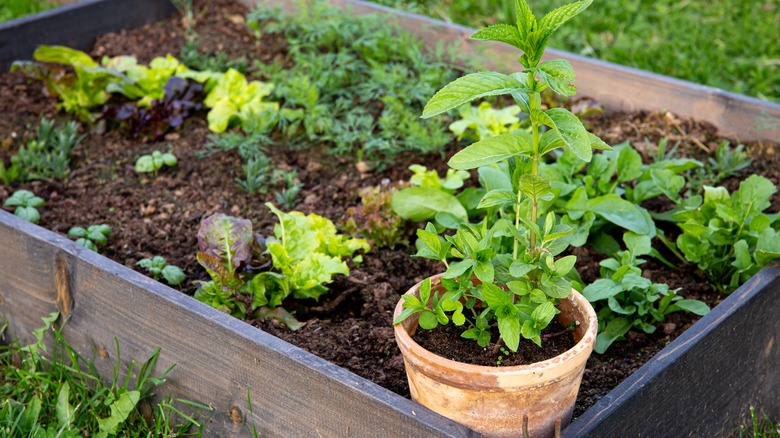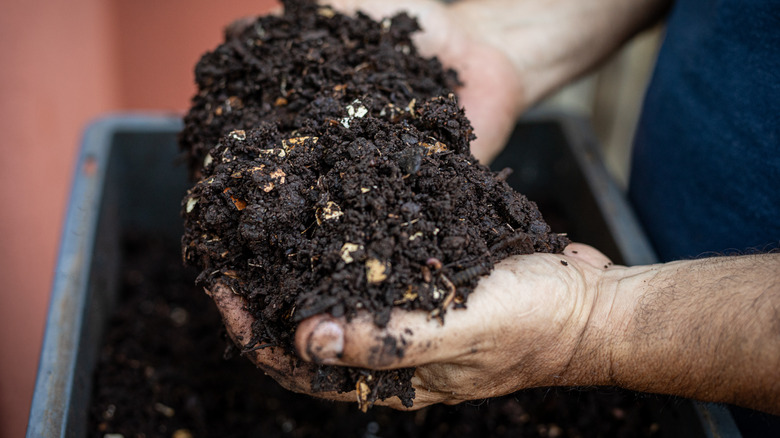Revive Your Garden Mint With A Beneficial Soil Tip
We may receive a commission on purchases made from links.
Garden mint, with countless varieties in the genus Mentha, is one herb that's almost too easy. Several varieties are considered invasive in the U.S. (check your state cooperative extension office), but many mints are not, though that doesn't quell some gardeners' fears of mint running rampant and taking over the world — or your corner of it. It's true that mint needs to be contained or it will run amok, which shows how important it is to follow Ina Garten's genius tip for growing fresh mint. Growing mint in a container is a good solution, but since nutrients in containers can be depleted, especially water-soluble nitrogen, according to NC State Extension, you'll need to revive your nitrogen-loving garden mint. And this revival starts in the soil where an interesting amendment is wiggling its way into the hearts of gardeners. Worms, especially red wigglers, get the honorable mint-ion for creating worm castings, which you can use just as you would compost, spreading the nutrient-rich material over the topsoil of the mint plants to give them a much-needed boost.
Hard-working worms decompose organic waste, and the castings they leave in their wake are essentially the byproduct of earthworms' natural processes. In other words, they are something akin to a worm's digestive output. Worm castings are rich in organic matter, and that's what makes them good for soil. So much so that 20 years ago, students at University of California, Santa Barbara, created the Associated Students Department of Public Worms (really!) to collect food scraps from the university, cultivate the worms (vermicomposting), and create compost for growing food for the campus.
Worm castings are mint to be used in your garden
Adding a layer of worm castings can revive your garden mint, but if you've never used worm castings before, you're probably wondering what they are, how you get them, and if you have to buy dozens of tiny litter boxes for worms in order to collect the castings to feed your mint plants. Luckily the answer to the last one is negative, but discovering what worms can do is fascinating and — if you're squeamish — a little bit icky. What the worms create, however, is gardener's gold, but you may wonder if worm castings are the same as compost. Not exactly; they're similar, but more nutrient-dense. They're also a better source of nitrogen and micronutrients. The added nitrogen is just what garden mint needs if the soil has been depleted, which is a common occurrence in potted plants.
Typically, when you think of composting, you think about how to make your own DIY compost. Place a bin in your yard where you add brown (like leaves) and green materials (like vegetable peels) to a plastic composter that you toss like a tumbler or create a fenced-in area that you rake with a pitchfork. When you collect worm castings, also called vermicomposting, they do all the work. It's easy to create a worm bin at home and "harvest" the castings as needed. If you'd prefer to purchase worm castings, Amazon has a 1-quart bag for $12.99.
A worm welcome to better mint plants
When TikTok user, thefrenchiegardener, encountered problems with his mint plants, he cut them down to the soil level. Then he spread a layer — about 1/2 inch to an inch — of worm castings over the mint and watered them in. Within a month, he saw healthy new growth from his perennial mint plants. Mint's aggressive nature (maybe the plant is just an overachiever) works best when it's planted in larger containers where it has room to spread.
If your mint is in a reasonably-sized container, you may be able to keep your mint plants happy and healthy during winter by giving them an indoor home temporarily. Find a sunny location away from heating or cooling ducts. If the weather is turning colder and you aren't bringing your mint plants indoors, worm castings can still be helpful for your outdoor plants. A layer of worm castings followed by some straw mulch at the end of the growing season can help the perennial herb overwinter in cooler climates. Remove the straw in the spring after what you expect is the last really cold day and let the sun do the rest of the job for you. Because mint appreciates a boost of nutrients, you'll want to get it off on the right foot in the spring by having it start the growing season in good soil.

